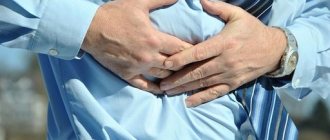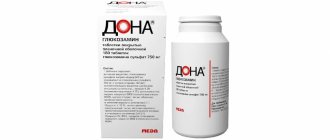Nimulid suspension bottle 50mg/5ml 60ml
A country
India
Country of manufacture may vary depending on the batch of goods. Please check with the operator for detailed information when confirming your order.
Active substance
Nimesulide
Compound
The active substance is nimesulide.
pharmachologic effect
Anti-inflammatory, antipyretic, analgesic. Selectively inhibits cyclooxygenase-2, suppresses prostaglandin synthesis at the site of inflammation. Inhibits lipid peroxidation and does not affect hemostasis and phagocytosis. After oral administration, it is well absorbed from the gastrointestinal tract. Maximum concentration is achieved after 1.5–2.5 hours. The half-life is 2-3 hours. Biotransformed in the liver. The main metabolite is the pharmacologically active hydroxynimesulide. It is excreted primarily by the kidneys. It does not accumulate with long-term use. Nise gel is a new generation non-steroidal anti-inflammatory drug (NSAID) from the sulfonamide class. It has a local analgesic and anti-inflammatory effect. When applied topically, it causes a weakening or disappearance of pain at the site of application of the gel, including pain in the joints at rest and during movement, reduces morning stiffness and swelling of the joints. Helps increase range of motion.
Indications for use
Osteoarthritis, osteoarthritis, bursitis, tendonitis, pain and inflammatory processes (in case of injuries, in the postoperative period, gynecological and infectious-inflammatory diseases). Nise gel: inflammatory and degenerative diseases of the musculoskeletal system (articular syndrome with rheumatism and exacerbation of gout, rheumatoid arthritis , psoriatic arthritis, ankylosing spondylitis, osteoarthritis, osteochondrosis with radicular syndrome, radiculitis, inflammatory damage to ligaments, tendons, bursitis, sciatica, lumbago). Muscle pain of rheumatic and non-rheumatic origin. Post-traumatic inflammation of soft tissues and the musculoskeletal system (damage and rupture of ligaments, bruises).
Interaction
It can increase the effectiveness and toxicity of many drugs, due to their displacement from sites of binding to plasma proteins and an increase in the free fraction in the blood (with the simultaneous administration of hydantoin and sulfonamides, regular medical supervision is required). Enhances the effect of medications that reduce blood clotting; increases plasma lithium levels.
Side effect
Headache, dizziness, drowsiness; very rarely - thrombocytopenia; nausea, heartburn, stomach pain, tarry stools, melena; petechiae, purpura; oliguria; allergic reactions (exanthema, erythema, urticaria). Nise gel: Local reactions: itching, urticaria, peeling, transient change in skin color (not requiring discontinuation of the drug). If any adverse reactions occur, you should stop using the drug and consult your doctor. When applying the gel to large areas of the skin, the development of systemic adverse reactions cannot be ruled out: heartburn, nausea, vomiting, diarrhea, gastralgia, ulceration of the gastrointestinal mucosa, increased activity of “liver” transaminases; headache, dizziness; fluid retention, hematuria; allergic reactions (anaphylactic shock, skin rash); thrombocytopenia, leukopenia, anemia, agranulocytosis, prolongation of bleeding time.
Contraindications
Hypersensitivity, peptic ulcer of the stomach and duodenum in the acute stage, severe dysfunction of the liver and kidneys, bleeding from the gastrointestinal tract, type 2 diabetes mellitus, arterial hypertension, congestive heart failure, pregnancy, lactation. Restrictions for use: children's age (up to 12 years ).
Overdose
Symptoms: increased severity of side effects. Treatment: gastric lavage, administration of activated charcoal.
special instructions
Prescribed with caution to elderly patients, with cardiovascular diseases, including arterial hypertension, bleeding tendency, disorders of the upper gastrointestinal tract, impaired renal function, during treatment with anticoagulants and antiplatelet agents. If visual disturbances occur, you should immediately stop taking the drug and consult an ophthalmologist. Patients with diabetes mellitus and patients on a low-calorie diet should take into account that the drug contains sucrose. Prescribe with caution to patients whose work requires increased attention and reaction speed.
Dispensing conditions in pharmacies
On prescription
Nimulid suspension for internal use 50mg/5ml 60ml
Compound
Active substance: nimesulide - 50 mg.
Excipients: xanthan gum 20.00 mg, non-crystallized sorbitol solution 500.00 mg, glycerin (glycerol) 150.00 mg, sucrose 1000.00 mg, macrogol glyceryl hydroxystearate (Cremophor RH 40) 10.00 mg, sodium methyl parahydroxybenzoate 9.00 mg, sodium propyl parahydroxybenzoate 1.00 mg, sodium benzoate 10.00 mg, colloidal silicon dioxide 10.00 mg, sodium disulfite 2.50 mg, citric acid monohydrate 1.25 mg, hydrochloric acid (conc.) 0.009 ml, flavoring agent vanilla 0.00218 ml, mango flavoring 0.00405 ml, quinoline yellow dye 0.275 mg, purified water qs up to 5 ml.
Pharmacokinetics
After oral administration, nimesulide is well absorbed from the gastrointestinal tract, Cmax in blood plasma is reached on average after 2-3 hours and is 3-4 mg/l. AUC is 20-35 mg×h/l. Plasma protein binding is 97.5%. After oral administration of a single dose of 100 mg, nimesulide is present in the tissues of the female genital organs in a concentration of 40% of the concentration in plasma. Metabolized in the liver with the participation of the CYP2C9 isoenzyme. The main metabolite is the pharmacologically active parahydroxy derivative of nimesulide - hydroxynimesulide, which is found exclusively in the form of glucuronate. Nimesulide is excreted from the body mainly in the urine (about 50% of the dose taken); about 29% is excreted in the form of metabolites in feces. T1/2 is 3.2-6 hours.
Indications for use
Rheumatoid arthritis, osteoarthritis, arthritis of various etiologies, arthralgia, myalgia, postoperative and post-traumatic pain, bursitis, tendonitis, algodismenorrhea, toothache and headache, including fever syndrome.
Contraindications
Hypersensitivity, erosive and ulcerative lesions of the gastrointestinal tract (in the acute phase), bleeding from the gastrointestinal tract, complete or incomplete combination of bronchial asthma, recurrent nasal polyposis or paranasal sinuses and intolerance to acetylsalicylic acid and other non-steroidal anti-inflammatory drugs (including history), any liver dysfunction, renal failure (creatinine clearance less than 30 ml/min), cerebrovascular bleeding, inflammatory bowel diseases (Crohn's disease, ulcerative colitis) in the acute phase, hemophilia and other bleeding disorders, decompensated chronic heart failure, history of hepatotoxic reactions when using nimesulide, alcoholism, drug addiction, progressive kidney disease, confirmed hyperkalemia, the period after coronary artery bypass surgery, concomitant use of other hepatotoxic drugs, pregnancy, lactation, children under 2 years of age.
Carefully:
Arterial hypertension, heart failure, type 2 diabetes mellitus, coronary heart disease, cerebrovascular diseases, dyslipidemia/hyperlipidemia, peripheral arterial disease, smoking, renal failure (creatinine clearance 30-60 ml/min), anamnestic data on the development of gastrointestinal ulcers tract, presence of Helicobacter pylori infection, old age, long-term use of non-steroidal anti-inflammatory drugs, alcoholism, severe somatic diseases, simultaneous | taking anticoagulants (including warfarin), antiplatelet agents (including acetylsalicylic acid, clopidogrel), oral glucocorticosteroids, selective serotonin reuptake inhibitors (including citalopram, fluoxetine, paroxetine, sertraline).
Directions for use and doses
Adults: orally, 100 mg (10 ml) 2 times a day.
The maximum daily dose for adults is 200 mg (20 ml). If you have diseases of the gastrointestinal tract, it is advisable to take the drug at the end of a meal or after a meal. Children from 2 years of age: orally, prescribed at the rate of a single dose of 1.5 mg/kg of the child’s body weight 2-3 times a day, the maximum daily dose of the drug is 5 mg/kg per day. For adolescents with body weight over 40 kg - 100 mg (10 ml) no more than 2 times a day.
Storage conditions
Store in a dry place, protected from light, at a temperature below 25°C.
Keep out of the reach of children.
Best before date
3 years. Do not use the drug after the expiration date indicated on the package.
special instructions
When prescribing the drug to elderly patients, no dosage adjustment is required.
With long-term use, systematic monitoring of liver and kidney function is necessary at least once every two weeks.
If signs of liver damage appear (skin itching, jaundice, nausea, vomiting, abdominal pain, dark urine, increased activity of liver transaminases), you should immediately stop taking the drug and consult a doctor.
Given reports of visual disturbances in patients taking other non-steroidal anti-inflammatory drugs, if any visual disturbance occurs, treatment should be stopped immediately and an ophthalmological examination performed.
The drug can cause fluid retention, so nimesulide should be used with extreme caution in patients with high blood pressure and heart disease.
Patients should undergo regular medical monitoring if they, along with nimesulide, take medications that are known to affect the gastrointestinal tract.
The drug should not be used simultaneously with other non-steroidal anti-inflammatory drugs.
Nimesulide can reduce platelet aggregation, but it does not replace the preventive action of antiplatelet agents (including acetylsalicylic acid, clopidogrel, ticlopidine) in cardiovascular diseases.
Description
NSAIDs.
Dosage form
A yellow suspension with an aromatic odor.
Use in children
Contraindication: children under 2 years of age.
Pharmacodynamics
NSAIDs from the sulfonanilide class, a selective competitive reversible inhibitor of COX-2.
Has anti-inflammatory, analgesic and antipyretic effects. It has a less pronounced inhibitory effect on COX-1. Reduces the concentration of short-lived prostaglandin H2, a substrate for kinin-stimulated synthesis of prostaglandin E2, at the site of inflammation and in the ascending pathways of pain impulses in the spinal cord. A decrease in the concentration of prostaglandin E2 (a mediator of inflammation and pain) reduces the activation of EP type prostanoid receptors, which is manifested by analgesic and anti-inflammatory effects.
Side effects
From the hematopoietic system: rarely - anemia, eosinophilia, hemorrhage; very rarely - thrombocytopenia, pancytopenia, thrombocytopenic purpura.
From the immune system: rarely - hypersensitivity reactions; very rarely - anaphylactoid reactions, very urticaria, angioedema.
From the skin and subcutaneous tissues: infrequently - itching, skin rash, increased sweating; rarely - erythema, dermatitis; very rarely - urticaria, facial swelling, erythema multiforme, Stevens-Johnson syndrome, toxic epidermal necrolysis (Lyell's syndrome).
From the nervous system: infrequently - dizziness; very rarely - headache, drowsiness, encephalopathy (Reye's syndrome).
Mental disorders: rarely - a feeling of fear, nervousness, nightmares.
From the organ of vision: rarely - blurred vision; very rarely - visual impairment.
From the organ of hearing and labyrinthine disorders: very rarely - vertigo.
From the cardiovascular system: infrequently - increased blood pressure; rarely - tachycardia, blood pressure lability, “flushes” of blood to the skin of the face, palpitations.
From the respiratory system: infrequently - shortness of breath; very rarely - exacerbation of bronchial asthma, bronchospasm.
From the digestive system: often - diarrhea, nausea, vomiting; uncommon - constipation, flatulence, gastritis, gastrointestinal bleeding, ulcer and/or perforation of the stomach or duodenum; very rarely - abdominal pain, dyspepsia, stomatitis, tarry stools.
From the liver and biliary tract: often - increased activity of liver enzymes; very rarely - hepatitis, fulminant hepatitis (including deaths), jaundice, cholestasis.
From the urinary system: rarely - dysuria, hematuria, urinary retention; very rarely - renal failure, oliguria, interstitial nephritis.
Metabolic disorders: rarely - hyperkalemia; uncommon - peripheral edema; very rarely - hypothermia.
Other: rarely - malaise, asthenia.
Use during pregnancy and breastfeeding
The use of the drug may adversely affect female fertility and is not recommended for women planning pregnancy.
Interaction
The effect of medications that reduce blood clotting is enhanced when used simultaneously with nimesulide.
Nimesulide may reduce the effect of furosemide. Nimesulide may increase the possibility of side effects while taking methotrexate. Plasma lithium levels increase when lithium and nimesulide are taken simultaneously.
Due to the high degree of binding of nimesulide to plasma proteins, patients who are simultaneously treated with hydantoin and sulfonamides should be under medical supervision, undergoing examinations at short intervals. Nimesulide may enhance the effect of cyclosporine on the kidneys.
Hepatotoxic drugs - increase the risk of hepatotoxicity. When used simultaneously with glucocorticosteroids and selective serotonin reuptake inhibitors, the risk of bleeding from the gastrointestinal tract increases.
Overdose
Symptoms: apathy, drowsiness, nausea, vomiting.
Symptoms are reversible with supportive care. Gastrointestinal bleeding, arterial hypertension, acute renal failure, and respiratory depression may occur. Treatment: The patient requires symptomatic treatment and supportive care. There is no specific antidote. If an overdose occurs within the last 4 hours, it is necessary to induce vomiting, take activated carbon (60-100 g per adult), and osmotic laxatives. Forced diuresis and hemodialysis are ineffective due to the high binding of the drug to proteins.
Impact on the ability to drive vehicles and operate machinery
Care must be taken when driving vehicles and engaging in other potentially hazardous activities that require increased concentration and speed of psychomotor reactions.
Buy Nimulid oral suspension 50mg/5ml 60ml in pharmacies
Instructions for use Nimulid Susp. internal 50mg/5ml 60ml
Dosage forms suspension Synonyms Aponil Nise Nemulex Nimesil Nimesulide Nimesulide-Teva Nimica Prolide Sulaydin Group Anti-inflammatory drugs of different groups International nonproprietary name Nimesulide Composition Active substance - nimesulide. Manufacturers Panacea Biotek Ltd (India) Pharmacological action Anti-inflammatory, antipyretic, analgesic. Selectively inhibits cyclooxygenase-2, suppresses prostaglandin synthesis at the site of inflammation. Inhibits lipid peroxidation and does not affect hemostasis and phagocytosis. After oral administration, it is well absorbed from the gastrointestinal tract. Maximum concentration is achieved after 1.5-2.5 hours. The half-life is 2-3 hours. Biotransformed in the liver. The main metabolite is the pharmacologically active hydroxynimesulide. It is excreted primarily by the kidneys. With long-term use it does not accumulate. Nise gel is a new generation non-steroidal anti-inflammatory drug (NSAID) from the sulfonamide class. It has a local analgesic and anti-inflammatory effect. When applied topically, it causes a weakening or disappearance of pain at the site of application of the gel, including pain in the joints at rest and during movement, reduces morning stiffness and swelling of the joints. Helps increase range of motion. Side effects Headache, dizziness, drowsiness; very rarely - thrombocytopenia; nausea, heartburn, stomach pain, tarry stools, melena; petechiae, purpura; oliguria; allergic reactions (exanthema, erythema, urticaria). Nise gel: Local reactions: itching, urticaria, peeling, transient change in skin color (not requiring discontinuation of the drug). If any adverse reactions occur, you should stop using the drug and consult your doctor. When applying the gel to large areas of the skin, the development of systemic adverse reactions cannot be ruled out: heartburn, nausea, vomiting, diarrhea, gastralgia, ulceration of the gastrointestinal mucosa, increased activity of “liver” transaminases; headache, dizziness; fluid retention, hematuria; allergic reactions (anaphylactic shock, skin rash); thrombocytopenia, leukopenia, anemia, agranulocytosis, prolongation of bleeding time. Indications for use Osteoarthritis, osteoarthritis, bursitis, tendonitis, pain and inflammatory processes (in case of injuries, in the postoperative period, gynecological and infectious-inflammatory diseases). Nise gel: inflammatory and degenerative diseases of the musculoskeletal system (articular syndrome with rheumatism and exacerbation of gout, rheumatoid arthritis, psoriatic arthritis, ankylosing spondylitis, osteoarthritis, osteochondrosis with radicular syndrome, radiculitis, inflammatory damage to the ligaments, tendons, bursitis, sciatica, lumbago) . Muscle pain of rheumatic and non-rheumatic origin. Post-traumatic inflammation of soft tissues and the musculoskeletal system (damage and rupture of ligaments, bruises). Contraindications Hypersensitivity, peptic ulcer of the stomach and duodenum in the acute stage, severe dysfunction of the liver and kidneys, bleeding from the gastrointestinal tract, type 2 diabetes mellitus, arterial hypertension, congestive heart failure, pregnancy, lactation. Restrictions on use: children's age (up to 12 years).
Dosage regimen. For adults, Nimulid is prescribed in the form of tablets, lingual tablets and an oral suspension at 100 mg 2 times a day. The tablets are taken orally with a sufficient amount of water at the end or after meals. The lingual tablet should be placed on the tongue, where it immediately begins to dissolve, then swallow the saliva in which the tablet has dissolved. The maximum daily dose is 200 mg. For children, Nimulid is prescribed in the form of a suspension for oral administration at a dose of 1.5 mg/kg body weight 2-3 times a day. The maximum dose for children is 5 mg/kg/day, divided into 2-3 doses. Nimulid in the form of a transdermal gel is intended for external use. Areas of skin treated with gel should not be covered with occlusive dressings. The gel should also not be rubbed vigorously into the skin. Approximately 3 cm of gel should be applied to the affected area 3-4 times a day. The dose, however, may vary depending on the size of the area being treated and the patient's response. The result of therapy is assessed after 4 weeks. When prescribing the drug to elderly patients, no dosage adjustment is required. Overdose Symptoms: increased severity of side effects. Treatment: gastric lavage, administration of activated carbon. Interaction May increase the effectiveness and toxicity of many drugs due to their displacement from sites of binding to plasma proteins and an increase in the free fraction in the blood (with the simultaneous administration of hydantoin and sulfonamides, regular medical supervision is required). Enhances the effect of medications that reduce blood clotting; increases plasma lithium levels. Special instructions Prescribe with caution to elderly patients, with cardiovascular diseases, including arterial hypertension, tendency to bleeding, disorders of the upper gastrointestinal tract, impaired renal function, during treatment with anticoagulants and antiplatelet agents. If visual disturbances occur, you should immediately stop taking the drug and consult an ophthalmologist. Patients with diabetes mellitus and patients on a low-calorie diet should take into account that the drug contains sucrose. Prescribe with caution to patients whose work requires increased attention and reaction speed.


